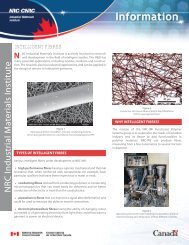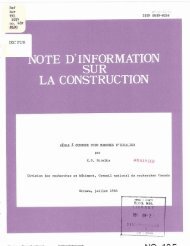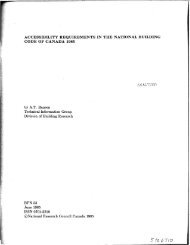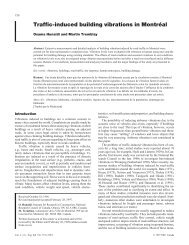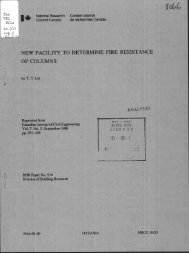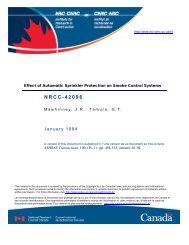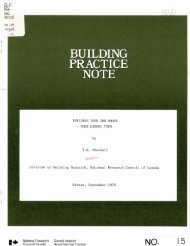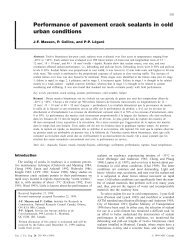AC pipe in North America: rehabilitation/replacement methods and ...
AC pipe in North America: rehabilitation/replacement methods and ...
AC pipe in North America: rehabilitation/replacement methods and ...
You also want an ePaper? Increase the reach of your titles
YUMPU automatically turns print PDFs into web optimized ePapers that Google loves.
http://www.nrc-cnrc.gc.ca/irc<strong>AC</strong> <strong>pipe</strong> <strong>in</strong> <strong>North</strong> <strong>America</strong>: <strong>rehabilitation</strong>/<strong>replacement</strong> <strong>methods</strong> <strong>and</strong>current practicesNRCC-51167Hu, Y.; Wang, D.L.; Baker, S.; Cossitt, K.August 2009A version of this document is published <strong>in</strong> / Une version de ce document se trouve dans:ASCE International Pipel<strong>in</strong>e Conference 2009 (San Diego, CA, USA, August16-19, 2009), pp. 1-10The material <strong>in</strong> this document is covered by the provisions of the Copyright Act, by Canadian laws, policies, regulations <strong>and</strong> <strong>in</strong>ternationalagreements. Such provisions serve to identify the <strong>in</strong>formation source <strong>and</strong>, <strong>in</strong> specific <strong>in</strong>stances, to prohibit reproduction of materials withoutwritten permission. For more <strong>in</strong>formation visit http://laws.justice.gc.ca/en/showtdm/cs/C-42Les renseignements dans ce document sont protégés par la Loi sur le droit d'auteur, par les lois, les politiques et les règlements du Canada etdes accords <strong>in</strong>ternationaux. Ces dispositions permettent d'identifier la source de l'<strong>in</strong>formation et, dans certa<strong>in</strong>s cas, d'<strong>in</strong>terdire la copie dedocuments sans permission écrite. Pour obtenir de plus amples renseignements : http://lois.justice.gc.ca/fr/showtdm/cs/C-42
consider other options for deal<strong>in</strong>g with ab<strong>and</strong>oned <strong>AC</strong> <strong>pipe</strong> debris such as decommission<strong>in</strong>gwhere this is feasible.3. SURVEY RESULTSThe survey questionnaire comprised 63 questions that covered five areas: background<strong>in</strong>formation, <strong>AC</strong> <strong>pipe</strong> <strong>in</strong>ventory <strong>and</strong> break history, condition assessment <strong>and</strong> performance,<strong>rehabilitation</strong> <strong>and</strong> <strong>replacement</strong>, <strong>and</strong> safety- <strong>and</strong> health-related management practices. Currentpractices for rehabilitat<strong>in</strong>g/replac<strong>in</strong>g <strong>AC</strong> <strong>pipe</strong>s used by the participat<strong>in</strong>g utilities <strong>and</strong> aresummarized <strong>in</strong> the follow<strong>in</strong>g sections.Rehabilitation/<strong>replacement</strong> programParticipat<strong>in</strong>g utilities were asked whether they have progressive programs <strong>in</strong> place for<strong>rehabilitation</strong>/<strong>replacement</strong> of <strong>AC</strong> <strong>pipe</strong>s <strong>in</strong> place. Of the 17 utilities that responded to thisquestion, n<strong>in</strong>e <strong>in</strong>dicated that they have such programs <strong>and</strong> use them for manag<strong>in</strong>g <strong>AC</strong> waterdistribution <strong>pipe</strong>s. The programs <strong>in</strong>cluded regular ma<strong>in</strong>tenance <strong>and</strong> strategic <strong>rehabilitation</strong>/<strong>replacement</strong>.Repair <strong>methods</strong> for broken <strong>AC</strong> sectionFigure 2 shows the <strong>methods</strong> used by participat<strong>in</strong>g utilities to repair broken <strong>AC</strong> <strong>pipe</strong>s. Of the 19utilities that responded, 37% replaced broken <strong>AC</strong> sections without any clamp<strong>in</strong>g. The othersrepaired broken <strong>pipe</strong>s by clamp<strong>in</strong>g one or more times before resort<strong>in</strong>g to <strong>replacement</strong> (depend<strong>in</strong>gon <strong>pipe</strong> conditions). As some utilities use more than one approach, the total can be more than100 percent. Some utilities replaced 100 mm diameter <strong>AC</strong> <strong>pipe</strong>s whenever a failure occurred.First failure, replacesectionFirst failure, clamp;second, failure, replacesectionFirst <strong>and</strong> second failure,clamp; third failure,replace sectionRepeated repair(clamp<strong>in</strong>g)Other0% 10% 20% 30% 40%Figure 2. Repair <strong>methods</strong> used by respond<strong>in</strong>g utilities for broken <strong>AC</strong> <strong>pipe</strong>s
Rehabilitated/replaced <strong>AC</strong> <strong>pipe</strong> lengthUtilities with <strong>rehabilitation</strong>/<strong>replacement</strong> programs were asked to report the length of <strong>AC</strong> <strong>pipe</strong>that was rehabilitated/replaced over the past six years. Eight utilities that responded to thisquestion (Figure 3). The length of <strong>AC</strong> <strong>pipe</strong> rehabilitated/replaced generally <strong>in</strong>creased dur<strong>in</strong>g thisperiod.Rehabilitation/<strong>replacement</strong> factorsWhen asked to <strong>in</strong>dicate the lead<strong>in</strong>g factors that determ<strong>in</strong>e which segments of <strong>AC</strong> <strong>pipe</strong> arerehabilitated or replaced, participat<strong>in</strong>g utilities cited ‘coord<strong>in</strong>ation with other capital projects’<strong>and</strong> ‘number of breaks’ (Figure 4). Pipe age, extent of deterioration <strong>and</strong> long-term strategy werealso factors frequently used to make <strong>rehabilitation</strong>/<strong>replacement</strong> decisions. Asbestos fibreconcentration <strong>in</strong> the conveyed water <strong>and</strong> strategic <strong>replacement</strong> due to health concern were theleast considered factors.28% of utilities (five of the 18 utilities that responded to this portion of the survey) alsoconsidered other criteria such as hydraulic limitations for fire-fight<strong>in</strong>g dem<strong>and</strong>, risk based onprobability of failure, consequence of failure, <strong>and</strong> social <strong>and</strong> environmental impact of breakage.4Average rehabilitated/replaced <strong>AC</strong> <strong>pipe</strong> per utility (km)32102002 2003 2004 2005 2006 2007Figure 3. Average rehabilitated/replaced <strong>AC</strong> <strong>pipe</strong> length <strong>and</strong> cost
Pipe ageExtent of <strong>pipe</strong>deteriorationAsbestos fiberconcentrationNumber ofbreaks/km/yearSR due to healthconcernSR based on longtermstrategyCoord<strong>in</strong>ation withother capital projectsOther0% 10% 20% 30% 40% 50% 60% 70% 80% 90%Figure 4. Factors determ<strong>in</strong><strong>in</strong>g <strong>pipe</strong> segment <strong>rehabilitation</strong> or <strong>replacement</strong>Rehabilitation/<strong>replacement</strong> priorityAlthough most utilities used the similar factors for decid<strong>in</strong>g which segments of <strong>AC</strong> <strong>pipe</strong>s were tobe rehabilitated or replaced, they put different weights on each of the factors. Table 1 shows thepriority factors of the 18 participat<strong>in</strong>g utilities. 39% of utilities (seven) ranked <strong>pipe</strong> breakage rateas the most important factor. 17% of utilities (three) ranked <strong>pipe</strong> age as the most importantfactor. One utility considered health concerns as the most important criterion. No utilityconsidered asbestos fiber concentration <strong>in</strong> the conveyed water is an important factor whenconsider<strong>in</strong>g the segments of <strong>AC</strong> <strong>pipe</strong>s to be rehabilitated or replaced.Replacement <strong>methods</strong>The common <strong>replacement</strong> <strong>methods</strong> used by the 17 participat<strong>in</strong>g utilities are shown <strong>in</strong> Figure 5.Utilities reported their use one or more of the <strong>methods</strong>. 88% (15 of 17 utilities) used trench<strong>in</strong>g asthe primary <strong>replacement</strong> method. About half the utilities (8 of 17) constructed a bypass when asegment of <strong>AC</strong> needed to be replaced. Two utilities (12%) <strong>in</strong>dicated that <strong>pipe</strong> burst<strong>in</strong>g was used.Pipe slipl<strong>in</strong><strong>in</strong>g was the least used method, used by only one utility (6%).
Table 1. Priority factors for <strong>pipe</strong> segment <strong>rehabilitation</strong>/<strong>replacement</strong>FactorPriority1 (highest) 2 3 4 5 6 78(lowest)Pipe age 17* 6 28 0 6 11 6 6Pipe deterioration 6 22 6 6 17 0 0 11Fiber concentration 0 6 0 0 6 0 11 17Breaks/km/year 39 11 11 17 0 6 0 6Health concern 6 0 11 0 6 6 17 0Long-term strategy 0 0 0 0 6 0 11 17Coord<strong>in</strong>ation 0 28 22 17 6 11 0 6Other 11 6 6 0 0 0 6 6* percentage of utilitiesThe primary reasons for choos<strong>in</strong>g a particular <strong>replacement</strong> method are summarized <strong>in</strong> Table 2.The most cited reason was service life improvement (47%), followed by total cost (40%) <strong>and</strong>previous experience (13%). Environmental effect (<strong>in</strong>clud<strong>in</strong>g possible active asbestos waste site)<strong>and</strong> social effect (<strong>in</strong>clud<strong>in</strong>g health concern due to activities related to cutt<strong>in</strong>g, demolish<strong>in</strong>g,h<strong>and</strong>l<strong>in</strong>g, <strong>and</strong> dispos<strong>in</strong>g <strong>AC</strong> <strong>pipe</strong> pieces or debris dur<strong>in</strong>g <strong>AC</strong> <strong>pipe</strong> <strong>replacement</strong>) were notconsidered as the first priority.Trench<strong>in</strong>gSlipl<strong>in</strong><strong>in</strong>gPipe burst<strong>in</strong>gLeave <strong>AC</strong> <strong>pipe</strong> <strong>in</strong> theground <strong>and</strong> constructa bypassOther0% 20% 40% 60% 80% 100%Figure 5. Replacement <strong>methods</strong> used by 17 participat<strong>in</strong>g utilities
Table 2. Replacement <strong>methods</strong> by rankFactor1(highest)Priority2 3 4 56(lowest)Total cost 40* 20 27 7 0 0Service life improvement 47 33 7 0 7 0Local availability 0 7 13 47 7 13Previous experience 13 20 33 7 13 7Social effect 0 7 7 0 40 27Environmental impact 0 0 7 27 20 27* percentage of utilitiesRehabilitation <strong>methods</strong>All 14 of the utilities that responded to queries about <strong>rehabilitation</strong> <strong>methods</strong> used trench<strong>in</strong>g(excavation <strong>and</strong> repair). Only one utility used cured-<strong>in</strong>-place <strong>pipe</strong> (CIPP) to rehabilitate <strong>AC</strong><strong>pipe</strong>s. Options not used <strong>in</strong>cluded cement mortar l<strong>in</strong><strong>in</strong>g, epoxy res<strong>in</strong> l<strong>in</strong><strong>in</strong>g, <strong>and</strong> slipl<strong>in</strong><strong>in</strong>g.Utilities were also asked about the reasons for choos<strong>in</strong>g a particular <strong>rehabilitation</strong> method <strong>and</strong>eight utilities responded (Table 3). Total cost was ranked as the most important consideration,followed by service life improvement, local availability, social effect, <strong>and</strong> previous experience.Environmental effect was not considered by any utilities.Table 3. Rehabilitation <strong>methods</strong> by rankFactor1(highest)Priority2 3 4 56(lowest)Total cost 25* 12.5 12.5 12.5 12.5 0Service life improvement 12.5 0 25 25 0 25Local availability 12.5 12.5 0 25 37.5 0Previous experience 12.5 25 12.5 12.5 12.5 25Social effect 12.5 25 12.5 12.5 12.5 12.5Environmental impact 0 0 0 0 0 0* percentage of utilities
4. CONCLUSIONSThis paper reviewed the <strong>rehabilitation</strong> <strong>and</strong> <strong>replacement</strong> <strong>methods</strong> available for <strong>AC</strong> water ma<strong>in</strong>s. Italso summarized data on the current <strong>rehabilitation</strong>/<strong>replacement</strong> practices of <strong>AC</strong> <strong>pipe</strong>s, obta<strong>in</strong>edfrom a survey of 19 participat<strong>in</strong>g utilities <strong>in</strong> the United Sates <strong>and</strong> Canada.In general, technologies used to renew non-<strong>AC</strong> water ma<strong>in</strong>s are applicable to <strong>AC</strong> water ma<strong>in</strong>s.However, the possibility that the asbestos <strong>in</strong> <strong>AC</strong> water ma<strong>in</strong>s becomes friable dur<strong>in</strong>g cutt<strong>in</strong>g ordemolition activities may become a factor <strong>in</strong> decid<strong>in</strong>g the <strong>methods</strong> to be used.Trench<strong>in</strong>g is the ma<strong>in</strong> method used by utilities to repair, rehabilitate, <strong>and</strong> replace <strong>AC</strong> <strong>pipe</strong>s. Costwas cited as the ma<strong>in</strong> reason of utilities for choos<strong>in</strong>g a particular repair/<strong>rehabilitation</strong>/<strong>replacement</strong> method. Of the many factors that determ<strong>in</strong>e the segment of <strong>AC</strong> <strong>pipe</strong>s to berehabilitated or to be replaced, coord<strong>in</strong>ation with other capital projects is the key considerationfor most utilities, followed by <strong>pipe</strong> breakage rate <strong>and</strong> <strong>pipe</strong> age. Although most of the<strong>rehabilitation</strong>/<strong>replacement</strong> <strong>methods</strong> have social <strong>and</strong> environmental effect because of possiblerelease of asbestos fibres dur<strong>in</strong>g these activities, the utilities generally did not consider it as theirhighest priority when select<strong>in</strong>g <strong>methods</strong> for renew<strong>in</strong>g <strong>AC</strong> <strong>pipe</strong>s.5. <strong>AC</strong>KNOWLEDGEMENTSThe authors wish to acknowledge the f<strong>in</strong>ancial support from National Research Council <strong>and</strong> theWRF. We also thank Dr. Jian Zhang, the project manager of the WRF project, <strong>and</strong> members ofthe project advisor committee, Toni Lyons, Steve MacKellar, Showri N<strong>and</strong>agiri, <strong>and</strong> Julie Spachtfor their useful suggestions dur<strong>in</strong>g the questionnaire development. We greatly appreciate thecontributions of the 19 participat<strong>in</strong>g utilities that submitted detailed <strong>AC</strong> <strong>pipe</strong> <strong>in</strong>formation.6. REFERENCES1. AWWA (<strong>America</strong>n Water Works Association). 1995. Work practices for asbestos-cement<strong>pipe</strong>. <strong>America</strong>n Water Works Association, Denver, CO2. BAAQMD (Bay Area Air Quality Management District). (2006). Compliance advisory:asbestos control requirements for <strong>pipe</strong> burst<strong>in</strong>g <strong>and</strong> <strong>pipe</strong> ream<strong>in</strong>g.http://www.baaqmd.gov/enf/compliance_assistance/advisories/adv_062006_asbestos_<strong>pipe</strong>_ream<strong>in</strong>g.pdf (accessed on May 12, 2008).3. Deb A. K., Hasit Y. J., Schoser H. M. <strong>and</strong> Snyder J. K. 2002. Decision support system fordistribution system pip<strong>in</strong>g renewal. <strong>America</strong>n Water Works Association ResearchFoundation <strong>and</strong> <strong>America</strong>n Water Works Association.4. DEQ (Department of Environmental Quality). 2006. How to remove nonfriable asbestos(<strong>AC</strong>) water <strong>pipe</strong>: a guide for meet<strong>in</strong>g DEQ rules.http://www.deq.state.or.us/AQ/asbestos/docs/ASBPIPE.pdf (accessed on May 1st, 2008).5. Hu, Y. <strong>and</strong> Hubble, D. 2007. Factors contribut<strong>in</strong>g to the failure of <strong>AC</strong> water ma<strong>in</strong>s. CanadianJournal of Civil Eng<strong>in</strong>eer<strong>in</strong>g, 34:1-14.
6. The International Society for Trenchless technology (ISTT). 2006. Trenchless Guidel<strong>in</strong>es.http://www.istt.com/<strong>in</strong>dex.cfm?menuID=74 (accessed on May 14, 2008)7. Kirmeyer, G.J., Richards, W. <strong>and</strong> Smith, C.D. 1994. An assessment of water distributionsystems <strong>and</strong> associated research needs. AwwaRF: Distribution Systems, Denver, CO.8. NRC (National Research Council). 2003. Selection of technologies for the <strong>rehabilitation</strong> or<strong>replacement</strong> of sections of a water distribution system – best practice. NRC, Ottawa, ON.9. Rajani, B.B. <strong>and</strong> McDonald, S.E. 1995. Water ma<strong>in</strong>s break data on different <strong>pipe</strong> materialsfor 1992 <strong>and</strong> 1993. National Research Council Canada, August 01, pp. 11.10. USEPA (United States Environmental Protection Agency). 2008 “Asbestos/NESHAPregulated asbestos conta<strong>in</strong><strong>in</strong>g materials guidance”http://www.epa.gov/region4/air/asbestos/asbmatl.htm (accessed on May 10th, 2008).11. Von Aspern, K. 2008. Asbestos cement <strong>pipe</strong>: what are the real rules. UndergroundConstruction Technology International Conference <strong>and</strong> Exposition, Atlanta, Georgia.




